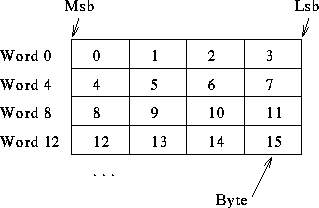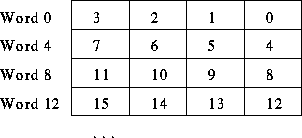- Big-endian:

- Little-endian:

Note that word addresses increase by 4.
Tom Kelliher, CS 220
Nov. 10, 1997
I encourage you to write your assembly from your pseudo-code, not the other way around.
m: .byte size_of_memory( .space is used to allocate bytes)
m[address]: byte access.
M[address]: word access. address must be aligned.
Definitions:


Note that word addresses increase by 4.
C++ indexed example:
char line[80];
int i;
i = 0; // 0 is index of first element of line
cin >> line[i]; // read a character into first element of line
while (line[i] != '\n') // read characters until end of line is reached
{
++i; // increment to index of next element of line
cin >> line[i]; // read next character
}
++i; // tack on a null character
line[i] = '\0';
i = 0; // print the line just read
while (line[i] != '\0')
{
cout << line[i];
++i;
}
line[i] = *(line + i * sizeof(char)).
line = &line[0].
C++ pointer example:
char line[80];
char *cp;
cp = line; // cp points to first element of line
cin >> *cp; // read a character into first element of line
while (*cp != '\n') // read characters until end of line is reached
{
++cp; // increment pointer to next element of line
cin >> *cp; // read next character
}
++cp; // tack on a null character
*cp = '\0';
cp = line; // print the line just read
while (*cp != '\0')
{
cout << *cp;
++cp;
}
SAL example:
&.
m[cp] corresponds to *cp.
.data
line: .byte '\0':80 # note how array declared
# initialization value not too
# important
cp: .word
.text
__start: la cp, line
get m[cp]
while1:
beq m[cp], '\n', ewhile1
add cp, cp, 1
get m[cp]
b while1
ewhile1:
add cp, cp, 1
move m[cp], '\0'
la cp, line
while2:
beq m[cp], '\0', ewhile2
put m[cp]
add cp, cp, 1
b while2
ewhile2:
done
A SAL program to read 10 ints, sort them into ascending order, and print the sorted list:
.data
data: .word 12:10
ptr: .word
nptr: .word
i: .word
k: .word # don't use j
temp: .word
prompt: .asciiz "? "
nl: .asciiz "\n"
.text
__start:
la ptr, data
move i, 10
while1: # read 10 ints
beqz i, ewhile1
puts prompt
get M[ptr]
sub i, i, 1
add ptr, ptr, 4
b while1
ewhile1:
move i, 9
while2: # outer loop of bubble sort
beqz i, ewhile2
la ptr, data
mul temp, 8, 4
add ptr, ptr, temp # ptr points to next to last
# element in data
move k, i
while3: # inner loop of bubble sort
beqz k, ewhile3
add nptr, ptr, 4 # nptr points to next element
# beyond ptr
if1: # compare & swap
ble M[ptr], M[nptr], eif1
move temp, M[ptr]
move M[ptr], M[nptr]
move M[nptr], temp
eif1:
sub k, k, 1
move nptr, ptr
sub ptr, ptr, 4
b while3
ewhile3:
sub i, i, 1
b while2
ewhile2:
la ptr, data
move i, 10
while4: # write 10 ints
beqz i, ewhile4
put M[ptr]
puts nl
sub i, i, 1
add ptr, ptr, 4
b while4
ewhile4:
done
Note: this will ``sorta'' work if you use m rather than M.
Consider the two-dimensional array:
int data[3][4];How much storage to allocate?
Conceptually:

How is it mapped onto the 1-D memory?

data[i][j]:
&data[i][j] = data
+ i * (# of columns) * (sizeof(data element))
+ j * (sizeof(data element))
# of columns = length of row.

data[i][j]?